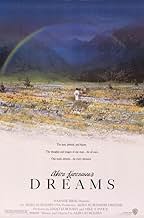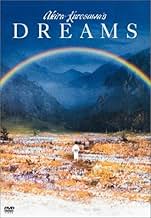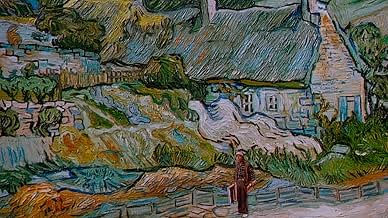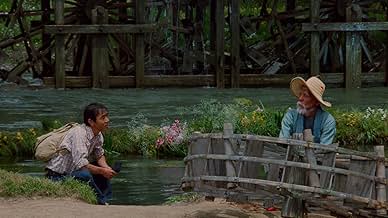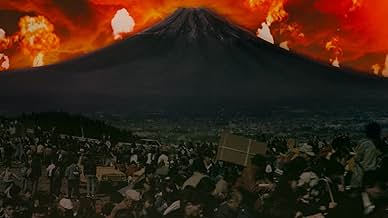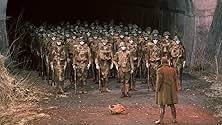- Premi
- 3 vittorie e 12 candidature totali
Recensioni in evidenza
Going back to what made Akira Kurosawa a star, Dreams is a film driven by a completely original concept. Like Rashomon, this is something that had never been done before. To my knowledge, nobody since has had the skill or guts to make a movie that accurately captures the spirit of........ bizarre Dreams. These stories are filmed and written just like real dreams. They're full of strange events that most of the time make no sense, yet everyone in the story totally believes it to be normal.
My favourite segments are "The Tunnel", as story where a former military commander encounters the ghosts of all the soldiers who died under his command. The Commander explaining why his soldiers died is hands down the best acting in the movie. My second favourite wold be "The Peach Orchard". This is about a young boy that finds a group of living dolls in the fields. The dolls are furious that the boy's family have destroyed all the peach tress in the Orchard. This segment was the most dreamlike. My third favourite would be "Mount Fuji In Red". In that there is a nuclear meltdown. Panic spreads and a few survivors contemplate whether or not to end their lives.
In traditional Kurosawa fashion, this movie is visually breathtaking. Kurosawa films don't just look great, they look unique and interesting. The visuals in Dreams helps create the hypnotic dream-like state. In the "Crows" story, a man enters the world of a Van Gogh painting. Parts of the scenery here are natural landscapes, and parts are made to look like a painting. In "Blizzard" mountain climbers are on the verge of death. They're rescued by a snow spirit. The blinding snow and the sort of slow motion effect when you see the Snow Fairy makes this segment perhaps the most hypnotic images Kurosawa has ever produced.
I wouldn't want anyone to get the idea that this is just a bunch of unconnected segments. Several characters appear in various segments, and some are meant to play back to back. I have to say that Dreams may not be for everyone. I'd recommend everyone alive check it out, though. Some may love it, some may not understand it. I'm on the side of this being one of the last brilliant works of the World's greatest Director.
My favourite segments are "The Tunnel", as story where a former military commander encounters the ghosts of all the soldiers who died under his command. The Commander explaining why his soldiers died is hands down the best acting in the movie. My second favourite wold be "The Peach Orchard". This is about a young boy that finds a group of living dolls in the fields. The dolls are furious that the boy's family have destroyed all the peach tress in the Orchard. This segment was the most dreamlike. My third favourite would be "Mount Fuji In Red". In that there is a nuclear meltdown. Panic spreads and a few survivors contemplate whether or not to end their lives.
In traditional Kurosawa fashion, this movie is visually breathtaking. Kurosawa films don't just look great, they look unique and interesting. The visuals in Dreams helps create the hypnotic dream-like state. In the "Crows" story, a man enters the world of a Van Gogh painting. Parts of the scenery here are natural landscapes, and parts are made to look like a painting. In "Blizzard" mountain climbers are on the verge of death. They're rescued by a snow spirit. The blinding snow and the sort of slow motion effect when you see the Snow Fairy makes this segment perhaps the most hypnotic images Kurosawa has ever produced.
I wouldn't want anyone to get the idea that this is just a bunch of unconnected segments. Several characters appear in various segments, and some are meant to play back to back. I have to say that Dreams may not be for everyone. I'd recommend everyone alive check it out, though. Some may love it, some may not understand it. I'm on the side of this being one of the last brilliant works of the World's greatest Director.
Most people dream but I wonder how many are rewarded with such beauty when their eyelids close and they drift into semi-consciousness. Kurosawa has collected some of his dreams and shares them with us. I don't ever remember seeing such vivid colours in my own dreams, but like Kurosawa's they are often fragmented and incomplete with a mystical quality involving spirits and the dead.
I like the peach tree scene where true repentance makes things right. Not only the peach blossom but also the kimono of the characters tiered up the hillside are most pleasing to the eye. As also is the meeting with van Gogh when his paintings with mad whirls of colour are brought to life and form part of the landscape.
Some dreams can be very frustrating when we are caught in a dangerous situation from which there is no ready means of escape. This is dramatically illustrated in the Mt. Fuji episode in which nuclear plants explode and a fog of coloured radio-active gases envelopes the characters. There is a strong message here about saving the environment. This message is also accented in the ogre scene and the peach tree scene and the water mill scene.
Some viewers might find the going slow at times. For example, the mountain climbers struggling in knee-deep snow seem to move at the rate of a few steps each minute and being encouraged by their leader to keep going as they strive to reach their camp. A mystical event occurs and in the morning when the heavy fog clears, a surprise awaits them. This feeling of striving and getting nowhere is common in dreams, at least in mine.
There is also mysticism involved in the tunnel scene where an ex-soldier meets the remainder of his platoon all of whom were killed in battle. The sound of their marching feet echoing through the empty tunnel is quite chilling.
Apart from a few dramatic moments the film is somewhat subdued. It is an art film beautifully conceived and should be reserved for one of those quiet moments when we are in a meditative mood.
I like the peach tree scene where true repentance makes things right. Not only the peach blossom but also the kimono of the characters tiered up the hillside are most pleasing to the eye. As also is the meeting with van Gogh when his paintings with mad whirls of colour are brought to life and form part of the landscape.
Some dreams can be very frustrating when we are caught in a dangerous situation from which there is no ready means of escape. This is dramatically illustrated in the Mt. Fuji episode in which nuclear plants explode and a fog of coloured radio-active gases envelopes the characters. There is a strong message here about saving the environment. This message is also accented in the ogre scene and the peach tree scene and the water mill scene.
Some viewers might find the going slow at times. For example, the mountain climbers struggling in knee-deep snow seem to move at the rate of a few steps each minute and being encouraged by their leader to keep going as they strive to reach their camp. A mystical event occurs and in the morning when the heavy fog clears, a surprise awaits them. This feeling of striving and getting nowhere is common in dreams, at least in mine.
There is also mysticism involved in the tunnel scene where an ex-soldier meets the remainder of his platoon all of whom were killed in battle. The sound of their marching feet echoing through the empty tunnel is quite chilling.
Apart from a few dramatic moments the film is somewhat subdued. It is an art film beautifully conceived and should be reserved for one of those quiet moments when we are in a meditative mood.
I was pleasantly surprised with dreams, not only in terms of content but also aesthetically. There are very few films that manage to embody personal, local and global concerns as Akira Kurosava has managed in this production. There are so many underlying topics that it is difficult to concentrate in just a few for the purpose of this review, but I believe it is fair to say that Dreams portrays our individual and collective dreams and nightmares, reflecting that sometimes what we dream of today is what will keep us awake tomorrow. A nice range of representations of concerns from the deepest and most personal childhood worries and fantasies to the more complex issues of mental illness, extreme ambition, destruction of our environment and death. In all I recommend this film to anyone who has the chance to see it, It is possible that Dreams may not appeal to a mainstream audience in terms of content because there is a lot of symbolism and critical engagement but the photography and sceneries are for sure something that should not go amiss for anyone. If you get the chance it is truly worth giving it your time, a fantastic experience.
Akira Kurosawa's insights on man's need to harmonize with nature, the costs of war and the bad fruits that nuclear power can bear. This is the first Kurosawa movie I have seen, but I can see how true it is that Kurosawa is a master of creating atmosphere in a film. Such as the dark, post-nuclear apocalyptic world of THE WEEPING DEMON. Or the very first episode when the little boy sees something he is not supposed to see in the forest.
I found THE BLIZZARD rather strange, and you'll see a scary part when the mountainman is having his mirage of the beautiful woman who symbolizes the snowstorm. I'm not sure what the significance of the dog was in THE TUNNEL, but I guess it illustrates the fact that though he was the commander of Third Platoon , he felt like a coward because of his command, his men paid the price.... yet he is guilty of still being alive; he's afraid of the dog.
It ends rather low key, but the last episode THE VILLAGE IN THE WATERMILLS is the most insightful and bold in expressing the movie's theme... of harmonizing with nature, and maybe harmonizing with ourselves.
The procession displays the unity and the communal harmony that the villagers have. And it is the exact opposite of what is grieved about in MOUNT FUJI IN RED or THE WEEPING DEMON. The cinematography is just beautiful. The movie is beautiful and captivating.
Akira Kurosawa's YUME is Grade A- 9/10
I found THE BLIZZARD rather strange, and you'll see a scary part when the mountainman is having his mirage of the beautiful woman who symbolizes the snowstorm. I'm not sure what the significance of the dog was in THE TUNNEL, but I guess it illustrates the fact that though he was the commander of Third Platoon , he felt like a coward because of his command, his men paid the price.... yet he is guilty of still being alive; he's afraid of the dog.
It ends rather low key, but the last episode THE VILLAGE IN THE WATERMILLS is the most insightful and bold in expressing the movie's theme... of harmonizing with nature, and maybe harmonizing with ourselves.
The procession displays the unity and the communal harmony that the villagers have. And it is the exact opposite of what is grieved about in MOUNT FUJI IN RED or THE WEEPING DEMON. The cinematography is just beautiful. The movie is beautiful and captivating.
Akira Kurosawa's YUME is Grade A- 9/10
Dreams is not a movie for everybody. To some, it may be too artsy of a film for their tastes (what are you doing watching movies then?), others may be annoyed by some of the stories not having clear messages, or leaving questions unanswered. Well, that is because Dreams is a film that was born inside of Kurosawa, and lives inside of him, it's a very personal film that not everybody will appreciate.
The movie consists of eight short stories. Most of which center around the issue of people's relationships with other elements that make up this world that we live in.
The cinematography in Dreams is breathtaking, and is the reason why some people claim that it is a film that puts "Style" above "story". I think that nobody can truly completely understand this film but Kurosawa himself. It is a product of his mind, a film that we cannot fully comprehend since we are not him. But since film is a form of art and in its truest form, a reflection of one's own self, Dreams may have just been one of Kurosawa's personal favorites in his long, amazing career.
The movie consists of eight short stories. Most of which center around the issue of people's relationships with other elements that make up this world that we live in.
The cinematography in Dreams is breathtaking, and is the reason why some people claim that it is a film that puts "Style" above "story". I think that nobody can truly completely understand this film but Kurosawa himself. It is a product of his mind, a film that we cannot fully comprehend since we are not him. But since film is a form of art and in its truest form, a reflection of one's own self, Dreams may have just been one of Kurosawa's personal favorites in his long, amazing career.
Lo sapevi?
- QuizAkira Kurosawa had trouble getting financing from studios in Japan, blaming much on the political nature of his criticism of nuclear power in the film. He sent a copy of his script to Steven Spielberg, who liked it, and helped get a deal for the film through Warner Bros.
- ConnessioniEdited into Gli ultimi giorni dell'umanità (2022)
- Colonne sonoreIn the Village
(from "Caucasian Sketches, Suite for Orchestra Op. 10, No. 2")
Music by Mikhail Ippolitov-Ivanov (as Ippolitov-Ivanov)
Conducted by Vladimir Fedoseyev (as Vladimir Fedoseev)
Performed by Moscow Radio Symphony Orchestra
I più visti
Accedi per valutare e creare un elenco di titoli salvati per ottenere consigli personalizzati
- How long is Dreams?Powered by Alexa
Dettagli
Botteghino
- Budget
- 12.000.000 USD (previsto)
- Lordo Stati Uniti e Canada
- 1.963.207 USD
- Lordo in tutto il mondo
- 2.970.161 USD
- Tempo di esecuzione
- 1h 59min(119 min)
- Colore
- Mix di suoni
- Proporzioni
- 1.85 : 1
Contribuisci a questa pagina
Suggerisci una modifica o aggiungi i contenuti mancanti



